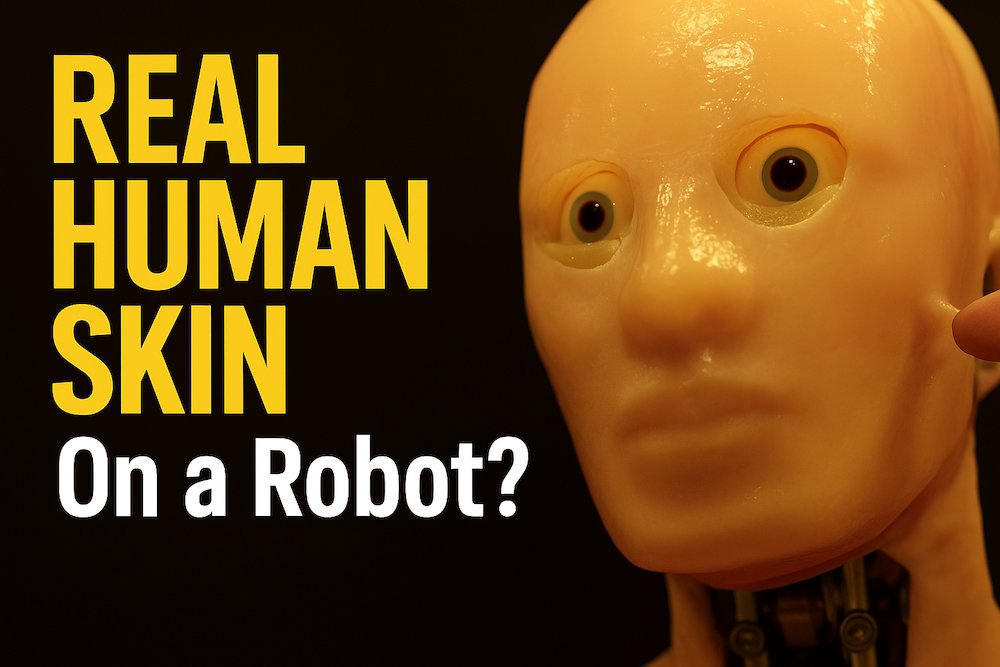Introduction: A Scientific Breakthrough In a Tokyo laboratory, researchers from the University of Tokyo have done the unthinkable: they created a robot covered in real human skin. Not only can it move and smile — it can also heal. This is a technological revolution that blurs the boundary between synthetic and biological life, raising massive implications for robotics, medicine, and ethics.
1. What Did the Researchers Actually Create? Led by Professor Shoji Takeuchi of the Biohybrid Systems Lab, the team grew layers of real human skin cells on a 3D face-shaped mold, then attached them to a robotic base. This skin includes both the dermis and epidermis, carefully cultivated to match human biology.
They created microscopic perforations in the robot’s structure, mimicking human ligaments, allowing the skin to stay flexible, durable, and securely attached.
2. How Does It Work? Instead of using silicone or latex, the researchers utilized a combination of collagen and lab-grown skin. The results? A robot that can smile without tearing its surface.
A special gel mimics the role of ligaments, sealing the skin onto the robot while maintaining elasticity and movement. The robot can perform facial expressions — such as smiling — without rupturing the biological material.
3. Why Is This a Biohybrid Robotics Milestone?
- Expression and Flexibility: Unlike synthetic materials, this living skin allows for realistic, human-like movements of the face.
- Self-Healing: The skin can naturally heal minor scratches or damage, making long-term applications more sustainable.
- Sensory Potential: The researchers aim to eventually integrate nerve-like sensors, allowing the skin to detect heat, touch, and pressure — crucial for medical, prosthetic, and caregiving applications.
4. Real-World Applications
| Field | Potential Uses |
|---|---|
| Medical & Surgical | Realistic simulators for training surgeons |
| Companion Robotics | Social robots that express human emotion |
| Cosmetic Industry | Testing dermatological products on live tissue |
| Sci-Fi & Entertainment | Lifelike androids in media and gaming |
5. Challenges and Limitations
- The skin currently lacks sweat glands, blood vessels, and full tactile sensitivity.
- Cultivation is time-consuming, expensive, and requires sterile lab conditions.
- Ethical concerns arise as the line between human and machine becomes harder to define. What happens when robots look indistinguishable from humans?
6. What’s Next? The next phase of research includes integrating blood vessels, nerves, and functional sweat glands. The researchers also envision using this technology in prosthetics, creating limbs that look, feel, and heal like human body parts.
The project also opens doors to using “face-on-chip” systems to test pharmaceuticals and cosmetic products on responsive biological tissue.
Affiliate Product Suggestions These affiliate products fit perfectly into the context of this article for curious minds and hobby scientists:
- Wireless Digital Microscope
Explore skin textures and cellular structures on your phone or tablet via Wi-Fi. Portable and beginner-friendly.
Buy on Amazon - Koolertron 4.3 Inch Digital Microscope with 1080P Resolution
Crystal-clear display, high magnification (up to 1000x), perfect for skin exploration, education, or macro photography.
Buy on Amazon - TOMLOV DM201 HDMI Digital Microscope (1080p)
Professional-grade scope with HDMI output and wide viewing angle. Ideal for capturing biological details in video or high-res stills.
Buy on Amazon
Conclusion: Why This Matters This breakthrough is more than a technical curiosity — it represents the merging of synthetic intelligence with biological realism. It challenges our understanding of identity, humanity, and the future of robotics.
We’re stepping into a world where machines may no longer feel like tools — but like beings. As this technology evolves, we will all have to answer one question: how human do we want our machines to become?
Watch the robot with real human skin move, blink, and react — it’s both fascinating and unsettling.
🎥 Watch the video on YouTube Shorts
You might also be curious about…Artificial Blood for Everyone? Japan’s Breakthrough That Could Save Millions
